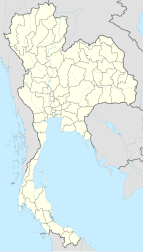Khao-I-Dang
| Khao-I-Dang Holding Center | |
|---|---|
| Refugee camp | |

KID April 1990
|
|
| Nickname(s): KID | |
| Location in Thailand | |
| Coordinates: 13°53′38″N 102°40′03″E / 13.89389°N 102.66750°ECoordinates: 13°53′38″N 102°40′03″E / 13.89389°N 102.66750°E | |
| Country |
|
| Constructed by UNHCR on the orders of the Royal Thai Government | November 21, 1979 |
| Area | |
| • Total | 2.3 km2 (0.9 sq mi) |
| Population (March 1980) | |
| • Total | 160,000 |
| • Density | 69,565/km2 (180,170/sq mi) |
Khao-I-Dang Holding Center was a Cambodian refugee camp located 20 km north of Aranyaprathet in Prachinburi (now Sa Kaeo) Province of Thailand. The most enduring refugee camp on the Thai-Cambodian border, it was established in late 1979 and administered by the Thai Ministry of the Interior and the United Nations High Commissioner for Refugees (UNHCR) -- unlike other camps on the border, which were administered by a coalition made up of UNICEF, the World Food Program, International Committee of the Red Cross (ICRC) (briefly) and, after 1982, the United Nations Border Relief Operation (UNBRO).
Situated on the sparsely wooded plains in eastern Thailand a few miles from the Cambodian border, the huge compound of bamboo and thatch houses was opened on November 21, 1979 after the fall of the Khmer Rouge. Following the establishment of an emergency camp for refugees at Sa Kaeo, the Thai Ministry of the Interior authorized Mark Malloch Brown of the UNHCR to build a second camp at the foot of Khao-I-Dang Mountain.
According to Martin Barber, Chief of UNHCR’s Kampuchean Unit, “The site, covering an area of 2.3 square kilometers on a gently sloping hill, had good drainage. It opened...after just four days of preparatory work spent in establishing the overall design of the camp and developing the basic infrastructure (roads, water tanks, and latrines) of the first “chunk”. The camp was divided into sections of 10,000-12,000 people. Each section had space allocated for reasonable housing and for necessary services including supplementary feeding.
...
Wikipedia

